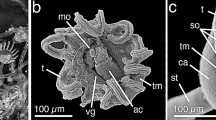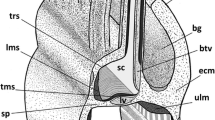Summary
The long tentacles of the Giant scallop Placopecten magellanicus (Gmelin) have been examined with light, scanning, and transmission electron microscopy. Three types of ciliated cells have been observed, one of which is located in specialised papillae born on the distal third of the tentacle. There are two separate cell types within the papillae. Type I cells are non-ciliated supporting cells, which form a capsule within which are found the Type II cells. These cells bear up to five cilia at their apices, and it is suggested that these are the receptor cells of the organ. No function has yet been determined for the receptors, but is suggested that they might be mechanoreceptors. A third cell type, Type III cells, occur at the base of the papillae. These cells bear many cilia and also macrocilia. Another ciliated cell type occurs on the proximal two thirds of the tentacle. These cells bear many cilia that are thought to be motile and not sensory.
Similar content being viewed by others
References
Barber, V.C.: The fine structure of the statocyst of Octopus vulgaris. Z. Zellforsch. 70, 91–107 (1966)
Barber, V.C.: The structure of mollusc statocysts, with particular reference to cephalopods. Symp. Zool. Soc. Lond. 23, 37–62 (1968)
Barber, V.C.: Cilia in sense organs. In: Cilia and Flagella (M. Sleigh, ed.), pp. 403–433. London: Academic Press 1974
Barber, V.C., Evans, E.M., Land, M.F.: The fine structure of the eye of the mollusc Pecten maximus. Z. Zellforsch. 76, 295–312 (1967)
Barber, V.C., Wright, D.E.: The fine structure of the eye and optic tentacle of the mollusc Cardium edule. J. Ultrastruct. Res. 26, 512–528 (1969)
Buddenbrock, W. von, Moller-Racke, I: Über den Lichtsinn von Pecten (translated). Pubbl. Staz. zool. Napoli, 24, 217–245 (1953)
Budelmann, B.U., Barber, V.C., West, S.: Scanning electron microscopical studies of the arrangement and numbers of hair cells in the statocysts of Octopus, Sepia, and Loligo. Brain Res. 56, 25–41 (1973)
Dakin, W.J.: Pecten. Proc. Liverpool Biol. Soc. 23, 332–468 (1909)
Dakin, WJ.: The eye of Pecten. Quart. J. micr. Sci. 55, 49–112 (1910).
Dakin, WJ.: The eyes of Pecten, Spondylus, Amussium and allied lamellibranchs with a short discussion on their evolution. Proc. roy. Soc. B 103, 355–365 (1928)
Drew, G.A.: The habits, anatomy and embryology of the Giant scallop Pecten tenuicostatus, Mighels. U. Maine Studies. No. 6, 71 p. (1906)
Eisig, H.: Monographie der Capitelliden des Golfes von Neapel. 906 pp. (1887)
Gibbons, I.R.: The relationship between the fine structure and the direction of beat in gill cilia of a lamellibranch mollusc. J. biophys. biochem. Cytol. 11, 179–205 (1961)
Graziadei, P.: Sensory receptor cells and related neurons in cephalopods. Cold. Spr. Harb. Symp. quant. Biol. 30, 45–53 (1965a)
Graziadei, P.: Electron microscope observations of some peripheral synapses in the sensory pathway of the sucker of Octopus vulgaris. Z. Zellforsch. 65, 363–379 (1965b)
Gutsell, J.S.: Natural history of the bay scallop. Bull. U.S. Bureau Fish. 46, 569–632 (1930)
Horridge, G.A.: Non-motile sensory cilia and neuro-muscular junctions in a ctenophore independent effector organ. Proc. roy. Soc. B 162, 333–350 (1965a)
Horridge, G.A.: Macrocilia with numerous shafts from the lips of the ctenophore Beroë. Proc. roy. Soc. B 162, 351–364 (1965b)
Horridge, G.A., Boulton, P.S.: Prey detection by Chaetognatha via a vibration sense. Proc. roy. Soc. B 168, 413–419 (1967)
Huxley, A.F.: A theoretical treatment of the reflexion of light by a multilayer structure. J. exp. Biol. 48, 227–245 (1968)
Ito, S., Loewenstein, W.R.: Ionic communication between early embryonic cells. Develop. Biol. 19, 228–243 (1969)
Knapp, M.F., Mill, P.J.: The fine structure of ciliated sensory cells in the epidermis of the earthworm Lumbricus terrestris. Tiss. Cell 3, 623–636 (1971)
Land, M.F.: The eye of the scallop; a concave reflector. J. Physiol. (Lond.) 175, 9–10P (1964)
Land, M.F.: Image formation by a concave reflector in the eye of the scallop Pecten maximus. J. Physiol. (Lond.) 179, 138–153 (1965)
Laverack, M.S.: On the receptors of marine invertebrates. Oceanogr. Mar. Biol. Ann. Rev. 6, 249–324 (1968)
Laverack, M.S.: The structure and function of chemoreceptor cells. In: Chemoreception in marine organisms.(P.T. Grant and A.M. Mackie, ed.), pp. 1–48. London: Academic Press 1974
List, T.: Die Mytelliden des Golfes von Neapel. Friedlander, Berlin (1902)
Lowe, G.A.: The occurrence of ciliary aggregations on the olfactory epithelium of two species of Gadoid fish. J. Fish. Biol. 6, 537–539 (1974)
Luft, J.H.: Improvements in Epoxy resin embedding methods. J. biophys. biochem. Cytol. 9, 409–414 (1961)
Miller, W.H.: Derivatives of cilia in the distal sense cells of the retina of Pecten. J. biophys. biochem. Cytol. 4, 227–228 (1958)
Millonig, G.: Advantages of a phosphate buffer for OsO4 solutions in fixation. J. appl. Physiol. 32, 1637 (1961)
Moir, A.J.G.: The structure of, and preliminary electrophysiological investigation upon, ciliated receptors in the Giant scallop, Placeopecten magellanicus (Gmelin). M.Sc. thesis, Memorial University of Newfoundland (1976)
Moritz, K., Storch, V.: Elektronenmikroskopische Untersuchung eines Mechanorezeptors von Evertebraten. (Priapuliden, Oligochaeten.). Z. Zellforsch. 117, 226–234 (1971)
Patten, W.: Eyes of molluscs and arthropods. J. Morph. 1, 542–756 (1887)
Potter, D.D., Furshpan, E.J. and Lennox, E.S.: Connections between cells of the developing squid as revealed by electrophysiological methods. Proc. nat Acad. Sci. (Wash.) 55, 328–333 (1966)
Renzoni, A.: Osservazioni istologiche, istochimiche ed ultrastrutturali sui tentacoli di Vaginulus borellianus (Colosi), Gastropoda Soleolifera. Z. Zellforsch. 87, 350–376 (1968)
Setna, S.B.: The neuromuscular mechanism of the gill of Pecten. Quart J. micr. Sci. 73, 365–393 (1930)
Stahlschmidt, V., Wolff, H.G.: The fine structure of the statocyst of the prosobranch mollusc Pomacea paludosa. Z. Zellforsch. 133, 529–537 (1972)
Theile, T.: Das abdominale Sinnesorgan der Lamellibranchier. Z. wiss. Zool. 48, 47–59 (1889)
Thomas, G.E., Gruffydd, Ll.D.: The types of escape reactions elicited in the scallop Pecten maximus by selected sea star species. Mar. Biol. (Berl.) 10, 87–93 (1971)
Thornhill, R.A.: The development of the lamptey (Lampetra fluviatilis Linn. 1758). Proc. roy. Soc. B 181, 175–198 (1972)
Trump, B.F., Smuckler, F.A., Benolitt, E.: A method for staining epoxy sections for light microscopy. J. Ultrastruct. Res. 5, 343–348 (1961)
Venable, J., Coggeshall, R.: A simplified lead citrate stain for use in electron microscopy. J. Cell Biol. 25, 407–408 (1965)
Watson, M.L.: Staining of tissue sections for electron microscopy with heavy metals. II. Applications for solutions containing lead and barium. J. biophys. biochem. Cytol. 4, 475–479 (1958)
White, K.M.: On typical British marine plants and animals. XXXI Mytilus. Liverpool Mar. Bio. Comm. 31, 1–117 (1937)
Wilson, J.A.F., Westerman, R.A.: The fine structure of the olfactory mucosa and nerve in the Teleost Carassius carassius. L. Z. Zellforsch. 83, 196–206. (1967)
Wolff, H.G.: Elektrische Antworten der Statonerven der Schnecken (Arion empiricorum und Helix pomatia) auf Drehreizung. Experientia (Basel) 24, 848–849 (1968)
Wolff, H.G.: Einige Ergebnisse zur Ultrastruktur der Statocysten von Limax maximus, Limax flavus und Arion empiricorum (Pulmonata). Z. Zellforsch. 100, 251–270 (1969)
Wolff, H.G.: Efferente Aktivität in den Statonerven einiger Landpulmonaten (Gastropoda). Z. vergl. Physiol. 70, 401–409 (1970)
Author information
Authors and Affiliations
Additional information
This research was supported by National Research Council of Canada Operating Grant No. A-6444 to Dr. V.C. Barber. Additional support came from the Department of Biology and School of Graduate Studies, Memorial University. Contribution No. 249 from the Marine Sciences Research Laboratory, Memorial University of Newfoundland
Rights and permissions
About this article
Cite this article
Moir, A.J.G. Ultrastructural studies on the ciliated receptors of the long tentacles of the giant scallop, Placopecten magellanicus (Gmelin). Cell Tissue Res. 184, 367–380 (1977). https://doi.org/10.1007/BF00219897
Accepted:
Issue Date:
DOI: https://doi.org/10.1007/BF00219897




